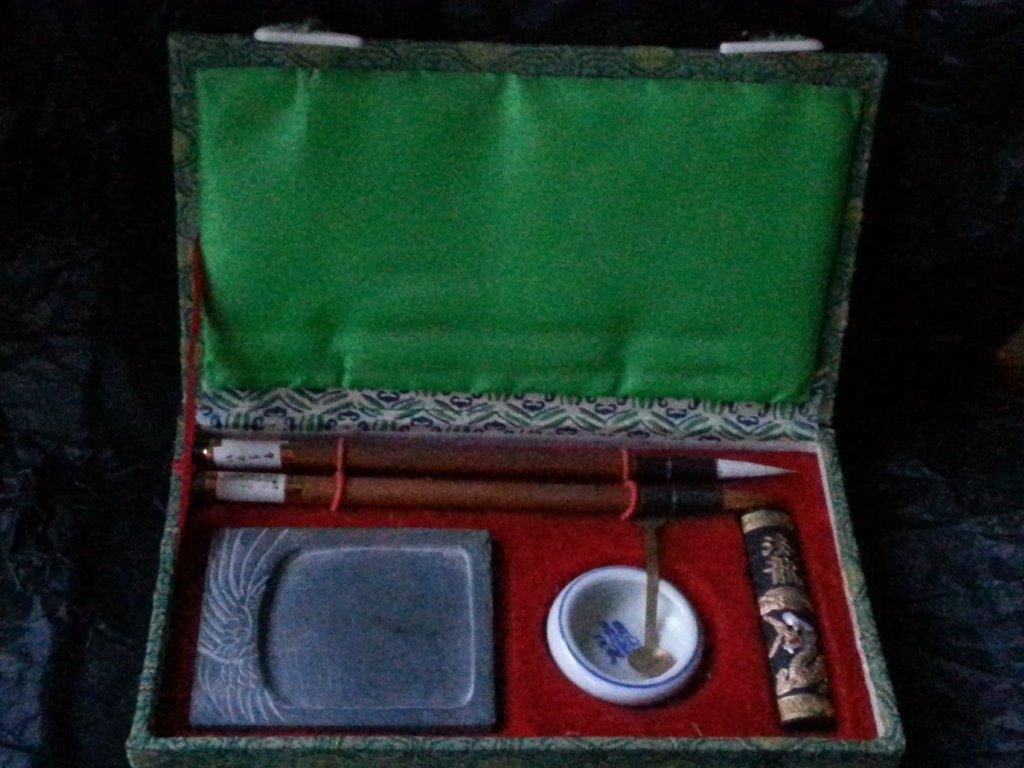Souvenir 011: Chinese Calligraphy and Painting Set – Ho Chi Minh City/Saigon, Vietnam, 2008
Chinese calligraphy is the writing of Chinese characters as an art form, combining purely visual art and interpretation of the literary meaning. This type of expression has been widely practiced in China and has been generally held in high esteem across East Asia. Calligraphy is considered one of the four most-sought skills and hobbies of ancient Chinese literati, along with playing stringed musical instruments, the board game “Go”, and painting. There are some general standardizations of the various styles of calligraphy in this tradition. Chinese calligraphy and ink and wash painting are closely related: they are accomplished using similar tools and techniques, and have a long history of shared artistry. Distinguishing features of Chinese painting and calligraphy include an emphasis on motion charged with dynamic life.

By Feng Chengsu (馮承素), original by Wang Xizhi (王羲之) – http://www.linyi.gov.cn/xizhi/zuopin/lanting.asp, Public Domain, https://commons.wikimedia.org/w/index.php?curid=552390
Materials and tools
In China as well as in Vietnam and probably more countries in Southeast Asia, Calligraphy Sets are sold in ornamented boxes like this one which The Wandelgek obtained in Ho Chi Minh City in Vietnam …
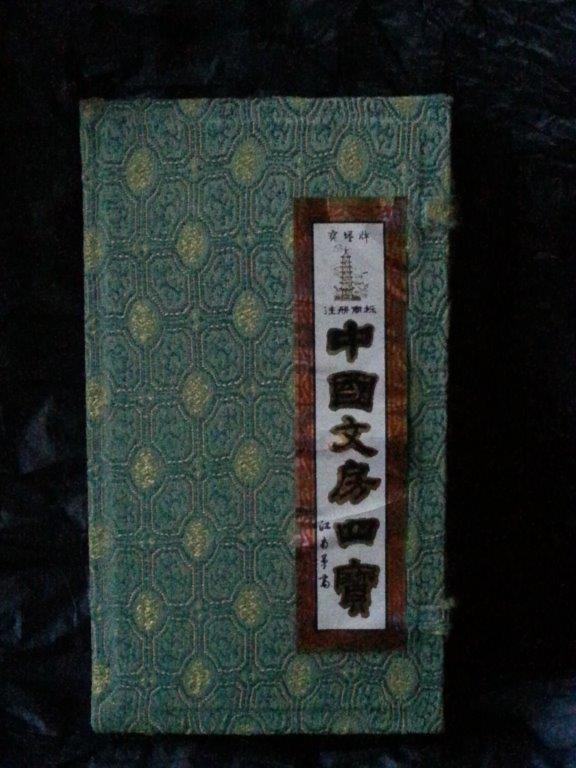 The ink brush, ink, paper, and inkstone are essential implements of Chinese calligraphy. They are known together as the Four Treasures of the Study. In addition to these four tools, a water-dropper, desk pads and paperweights are also used by calligraphers. The box beneath containes two brushes (one dark brown tipped and one white tipped), an inkstone, an inkstick and a water-dropper with a tiny spoon.
The ink brush, ink, paper, and inkstone are essential implements of Chinese calligraphy. They are known together as the Four Treasures of the Study. In addition to these four tools, a water-dropper, desk pads and paperweights are also used by calligraphers. The box beneath containes two brushes (one dark brown tipped and one white tipped), an inkstone, an inkstick and a water-dropper with a tiny spoon.
Brush
A brush is the traditional writing instrument for Chinese calligraphy. The body of the brush is commonly made from bamboo or other materials such as wood, porcelain, or horn. The head of the brush is typically made from animal hair, such as weasel, rabbit, deer, goat, pig, tiger, wolf, etc. There is also a tradition in both China and Japan of making a brush using the hair of a newborn child, as a once-in-a-lifetime souvenir. This practice is associated with the legend of an ancient Chinese scholar who scored first in the imperial examinations by using such a personalized brush. Calligraphy brushes are widely considered an extension of the calligrapher’s arm.
Today, calligraphy may also be done using a pen.
Paper
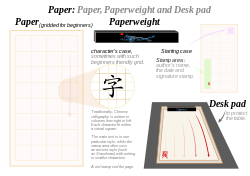
Paper is frequently sold together with a paperweight and desk pad.
Some people insist that Chinese calligraphy should use special papers, such as Xuan paper, Maobian paper, Lianshi paper etc. Any modern papers can be used for brush writing. Because of the long-term uses, Xuan paper became well known by most of Chinese calligraphers.
In China, Xuanzhi (宣紙), traditionally made in Anhui province, is the preferred type of paper. It is made from the Tatar wingceltis (Pteroceltis tatarianovii), as well as other materials including rice, the paper mulberry (Broussonetia papyrifera), bamboo, hemp, etc.
In Japan, washi is made from the kozo (paper mulberry), ganpi (Wikstroemia sikokiana), and mitsumata (Edgeworthia papyrifera), as well as other materials such as bamboo, rice, and wheat.
Paperweights
Paperweights are used to hold down paper. A paperweight is often placed at the top of all but the largest pages to prevent slipping; for smaller pieces the left hand is also placed at the bottom of the page for support. Paperweights come in several types: some are oblong wooden blocks carved with calligraphic or pictorial designs; others are essentially small sculptures of people or animals. Like ink stones, paperweights are collectible works of art on their own right.
Desk pads
The desk pad is a pad made of felt. Some are printed with grids on both sides, so that when it is placed under the translucent paper, it can be used as a guide to ensure correct placement and size of characters. However, these printed pads are used only by students. Both desk pads and the printed grids come in a variety of sizes.
Ink and inkstick
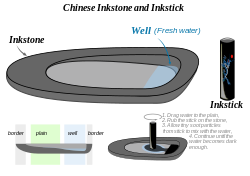

Ink is made from lampblack (soot) and binders, and comes in inksticks which must be rubbed with water on an inkstone until the right consistency is achieved. Much cheaper, pre-mixed bottled inks are now available, but these are used primarily for practice as stick inks are considered higher quality and chemical inks are more prone to bleeding over time, making them less suitable for use in hanging scrolls. Learning to rub the ink is an essential part of calligraphy study. Traditionally, Chinese calligraphy is written only in black ink, but modern calligraphers sometimes use other colors. Calligraphy teachers use a bright orange or red ink with which they write practice characters on which students trace, or to correct students’ work.
Inkstone
Commonly made from stone, ceramic, or clay, an inkstone is used to grind the solid inkstick into liquid ink and to contain the ink once it is liquid. Chinese inkstones are highly prized as art objects and an extensive bibliography is dedicated to their history and appreciation, especially in China.
Seal and seal paste

Calligraphic works are usually completed by the calligrapher applying one or more seals in red ink. The seal can serve the function of a signature.
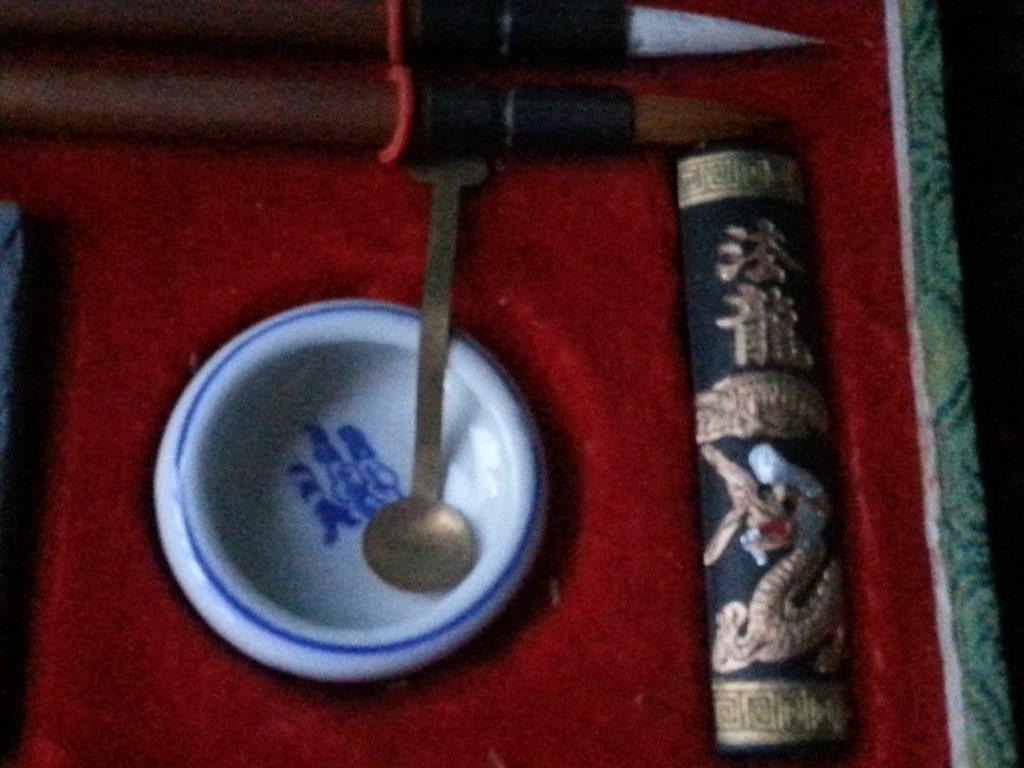 Besides its practical use, it is obvious that this set and its box were made to impress the beholder.
Besides its practical use, it is obvious that this set and its box were made to impress the beholder.

